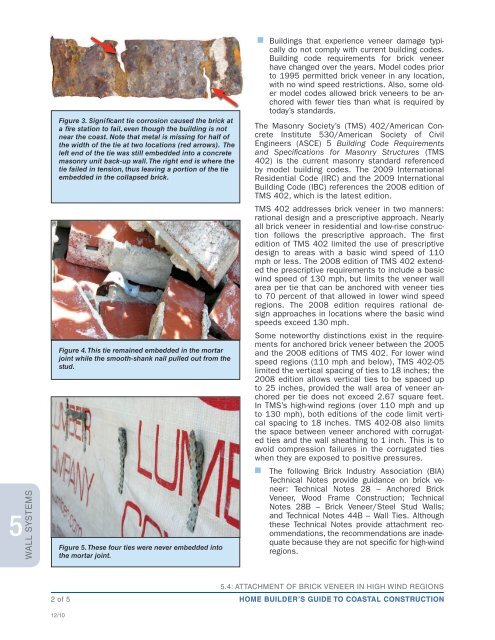FEMA P-499: Home Builder's Guide to Coastal Construction
FEMA P-499: Home Builder's Guide to Coastal Construction
FEMA P-499: Home Builder's Guide to Coastal Construction
You also want an ePaper? Increase the reach of your titles
YUMPU automatically turns print PDFs into web optimized ePapers that Google loves.
5<br />
WALL SYSTEMS<br />
Figure 3. Significant tie corrosion caused the brick at<br />
a fire station <strong>to</strong> fail, even though the building is not<br />
near the coast. Note that metal is missing for half of<br />
the width of the tie at two locations (red arrows). The<br />
left end of the tie was still embedded in<strong>to</strong> a concrete<br />
masonry unit back-up wall. The right end is where the<br />
tie failed in tension, thus leaving a portion of the tie<br />
embedded in the collapsed brick.<br />
Figure 4. This tie remained embedded in the mortar<br />
joint while the smooth-shank nail pulled out from the<br />
stud.<br />
Figure 5. These four ties were never embedded in<strong>to</strong><br />
the mortar joint.<br />
2 of 5<br />
12/10<br />
n Buildings that experience veneer damage typically<br />
do not comply with current building codes.<br />
Building code requirements for brick veneer<br />
have changed over the years. Model codes prior<br />
<strong>to</strong> 1995 permitted brick veneer in any location,<br />
with no wind speed restrictions. Also, some older<br />
model codes allowed brick veneers <strong>to</strong> be anchored<br />
with fewer ties than what is required by<br />
<strong>to</strong>day’s standards.<br />
The Masonry Society’s (TMS) 402/American Concrete<br />
Institute 530/American Society of Civil<br />
Engineers (ASCE) 5 Building Code Requirements<br />
and Specifications for Masonry Structures (TMS<br />
402) is the current masonry standard referenced<br />
by model building codes. The 2009 International<br />
Residential Code (IRC) and the 2009 International<br />
Building Code (IBC) references the 2008 edition of<br />
TMS 402, which is the latest edition.<br />
TMS 402 addresses brick veneer in two manners:<br />
rational design and a prescriptive approach. Nearly<br />
all brick veneer in residential and low-rise construction<br />
follows the prescriptive approach. The first<br />
edition of TMS 402 limited the use of prescriptive<br />
design <strong>to</strong> areas with a basic wind speed of 110<br />
mph or less. The 2008 edition of TMS 402 extended<br />
the prescriptive requirements <strong>to</strong> include a basic<br />
wind speed of 130 mph, but limits the veneer wall<br />
area per tie that can be anchored with veneer ties<br />
<strong>to</strong> 70 percent of that allowed in lower wind speed<br />
regions. The 2008 edition requires rational design<br />
approaches in locations where the basic wind<br />
speeds exceed 130 mph.<br />
Some noteworthy distinctions exist in the requirements<br />
for anchored brick veneer between the 2005<br />
and the 2008 editions of TMS 402. For lower wind<br />
speed regions (110 mph and below), TMS 402-05<br />
limited the vertical spacing of ties <strong>to</strong> 18 inches; the<br />
2008 edition allows vertical ties <strong>to</strong> be spaced up<br />
<strong>to</strong> 25 inches, provided the wall area of veneer anchored<br />
per tie does not exceed 2.67 square feet.<br />
In TMS’s high-wind regions (over 110 mph and up<br />
<strong>to</strong> 130 mph), both editions of the code limit vertical<br />
spacing <strong>to</strong> 18 inches. TMS 402-08 also limits<br />
the space between veneer anchored with corrugated<br />
ties and the wall sheathing <strong>to</strong> 1 inch. This is <strong>to</strong><br />
avoid compression failures in the corrugated ties<br />
when they are exposed <strong>to</strong> positive pressures.<br />
n The following Brick Industry Association (BIA)<br />
Technical Notes provide guidance on brick veneer:<br />
Technical Notes 28 – Anchored Brick<br />
Veneer, Wood Frame <strong>Construction</strong>; Technical<br />
Notes 28B – Brick Veneer/Steel Stud Walls;<br />
and Technical Notes 44B – Wall Ties. Although<br />
these Technical Notes provide attachment recommendations,<br />
the recommendations are inadequate<br />
because they are not specific for high-wind<br />
regions.<br />
5.4: ATTACHMENT OF BRICK VENEER IN HIGH WIND REGIONS<br />
HOME BUILDER’S GUIDE TO COASTAL CONSTRUCTION


